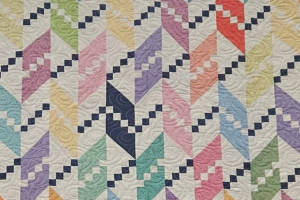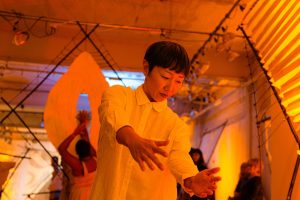Trust Your Guts: a fascination with practices, prayers, and prescriptions

As a creative with many passions, Erin Lea Lorenzen cannot be tied to one medium on an everyday basis. Instead, she dabbles in a bit of everything including pottery, yoga, screen printing, and teaching. Her work explores her fascination with the objects, rituals, and routines of daily life, and her pieces investigate how people fill their days: the items they use, the habits they maintain, what they devote themselves to, and why. She also wonders when our practices, prayers, and prescriptions are doing us good and when they aren’t, and believes in the importance of trusting in intuition both within a creative space and in everyday life.
“Pretty much everything inspires me to create,” Lorenzen said. “I’ve been making things for about as long as I can remember and my process is very organic. Everything that appears in my life becomes part of the work.”
Lorenzen said she has been working with fabric for a long period of time and especially enjoys working with materials that have been used, worn, and discarded. Her current show, “Trust Your Guts,”at the Anne Kittrell Art Gallery, is a curation of pieces from multiple series and showcases pieces inspired by the book The Body Keeps the Score, by Bessel van der Kolk, the Women’s Rights Movement, and the traditions of quilting and sewing.
“I’m devoting time to these works in hopes of encouraging not only women, but everyone to listen to what their bodies are telling them rather than silencing those instincts to fit the mold society has made for them,” Lorenzen said.
Lorenzen’s experience as a potter and a yogi continue to inspire her current work.
“I have always been especially interested in creating vessels—their form mimics our form, Lorenzen said. “As I am making them, I am thinking of the all things we have as humans, what we hold, what we keep, what we use, and why.”
As for the yoga mats, Lorenzen said she repurposes discarded mats and finds that the themes of repair and rescue are reflected in her work.
As a long-time practitioner of both art and yoga, Lorenzen said she finds the practices similar in that they both deal aspects of the material and immaterial.
“Both practices have different techniques that serve as tools to experientially connect the mental, the physical, and the spiritual to each other,” Lorenzen said. “Doing this can be an awesome opportunity to move beyond the habitual ways of day-to-day living, and create space for personal contemplation, mental relaxation, exploration in a meditative state, and reflection on the bigger picture.”





Comments